牛津译林版(2019)选择性必修 第一册Unit 4 Exploring poetry Grammar and usage课件(共40张PPT)
文档属性
| 名称 | 牛津译林版(2019)选择性必修 第一册Unit 4 Exploring poetry Grammar and usage课件(共40张PPT) | 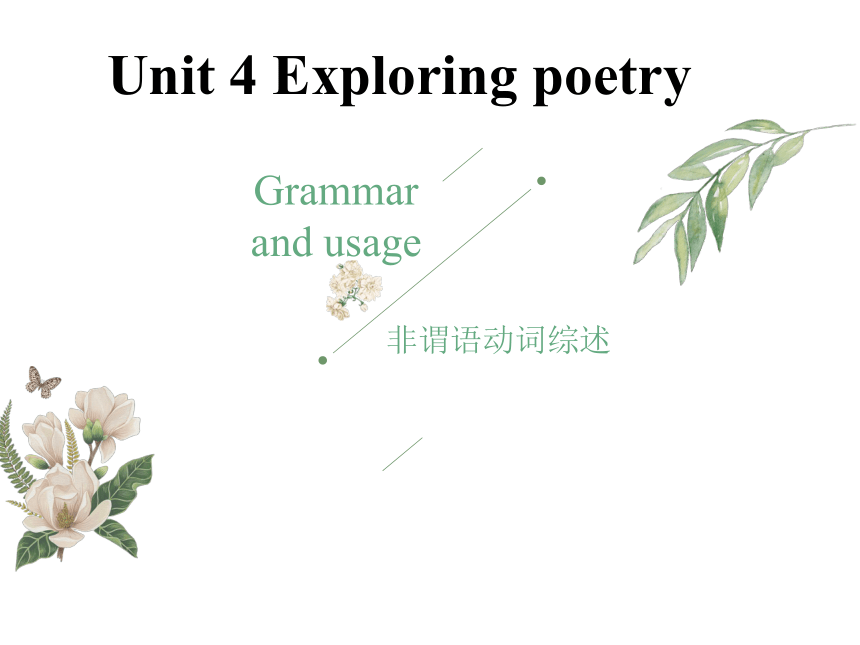 | |
| 格式 | pptx | ||
| 文件大小 | 24.7MB | ||
| 资源类型 | 教案 | ||
| 版本资源 | 牛津译林版(2019) | ||
| 科目 | 英语 | ||
| 更新时间 | 2023-07-30 13:31:19 | ||
图片预览


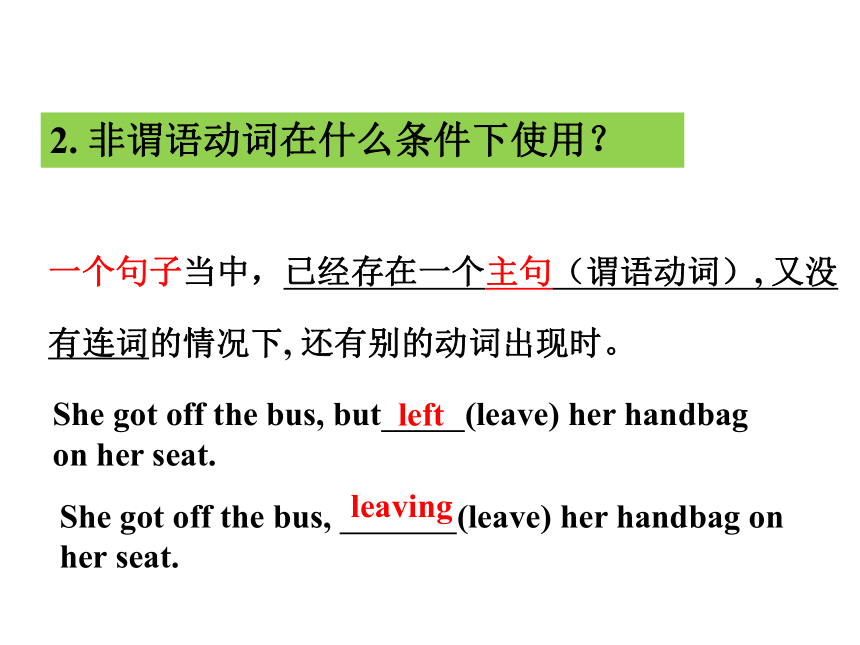
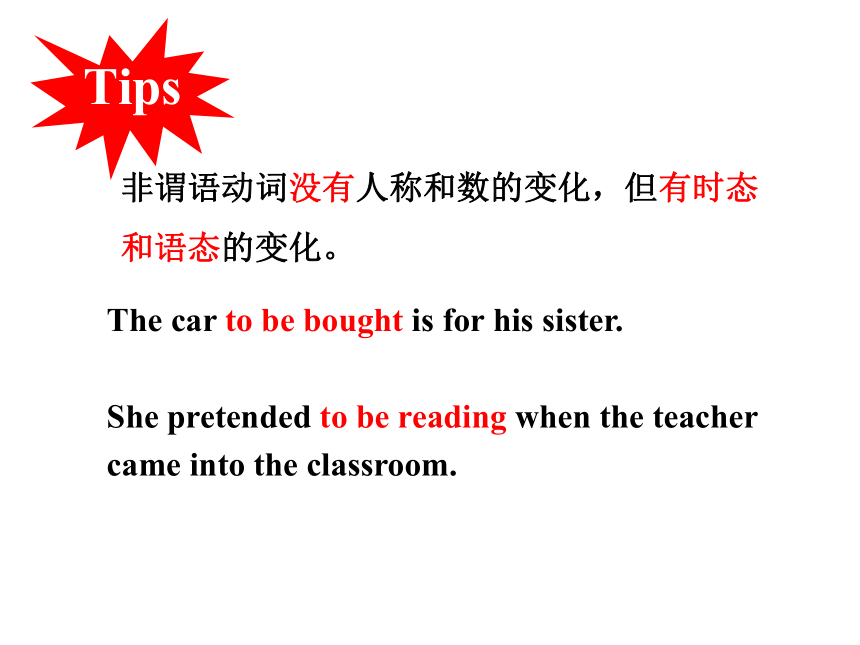
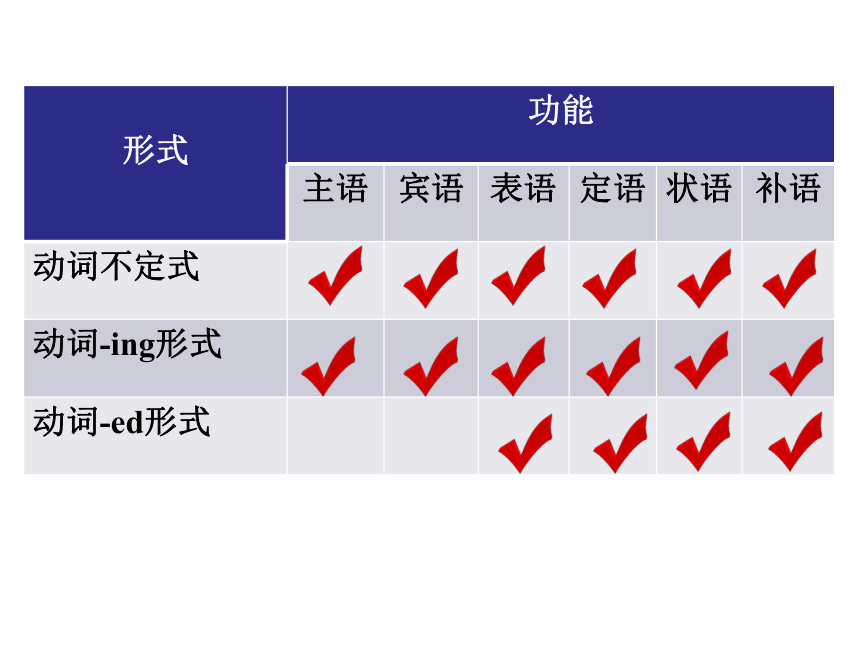


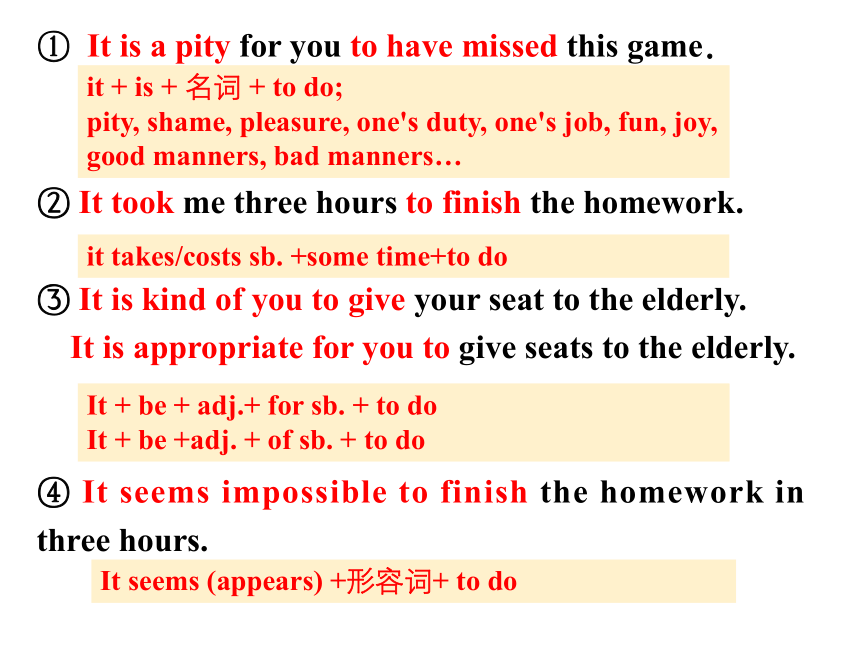

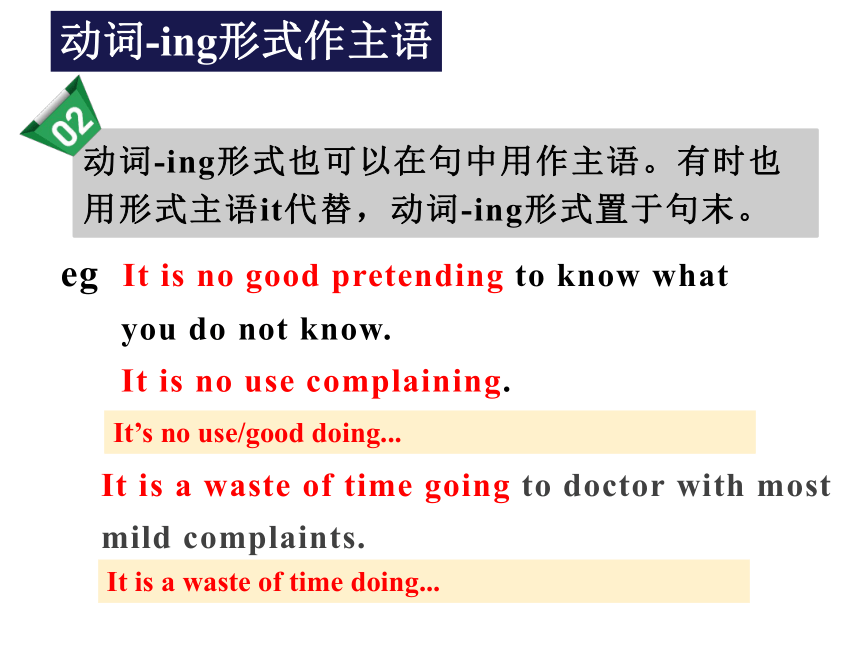
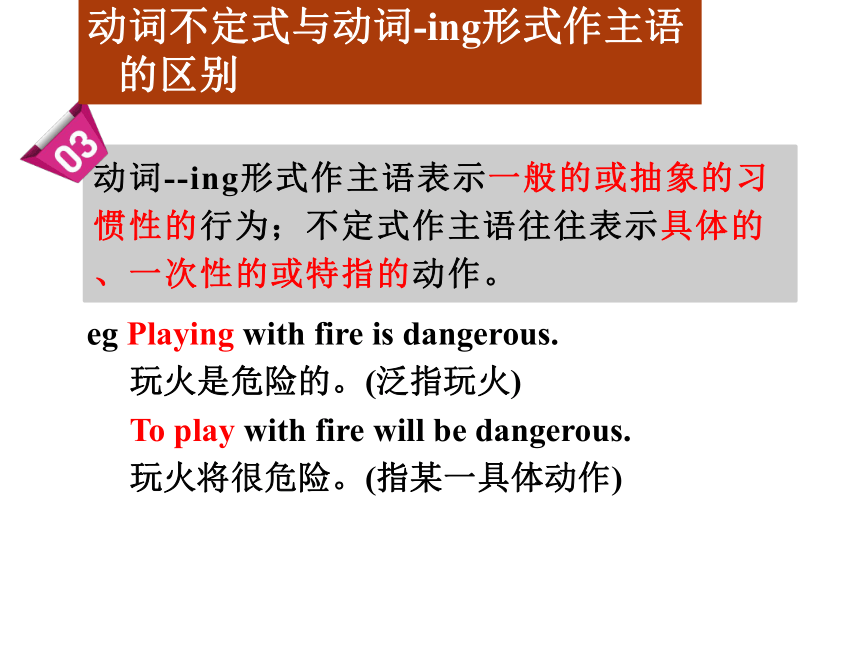

文档简介
(共40张PPT)
Grammar and usage
非谓语动词综述
Unit 4 Exploring poetry
非谓语动词首先是一种动词形式,其次是这种动词形式不能做谓语。非谓语动词通常指动词不定式、动词-ing形式和动词-ed形式,在句中可用作主语、宾语、表语、定语、状语和补语。
非谓语动词
1.什么是非谓语动词
一个句子当中,已经存在一个主句(谓语动词), 又没有连词的情况下, 还有别的动词出现时。
She got off the bus, (leave) her handbag on her seat.
2. 非谓语动词在什么条件下使用?
She got off the bus, but (leave) her handbag on her seat.
left
leaving
非谓语动词没有人称和数的变化,但有时态和语态的变化。
The car to be bought is for his sister.
She pretended to be reading when the teacher came into the classroom.
Tips
形式 功能
主语 宾语 表语 定语 状语 补语
动词不定式
动词-ing形式
动词-ed形式
非谓语作主语
动词不定式可以在句中用作主语。不定式作主语时常常用形式主语it代替,不定式置于句末。
eg Collecting stamps is my hobby.
→It is my hobby to collect stamps.
动词不定式作主语
① It is a pity for you to have missed this game.
② It took me three hours to finish the homework.
③ It is kind of you to give your seat to the elderly.
It is appropriate for you to give seats to the elderly.
④ It seems impossible to finish the homework in three hours.
it + is + 名词 + to do;
pity, shame, pleasure, one's duty, one's job, fun, joy, good manners, bad manners…
it takes/costs sb. +some time+to do
It + be + adj.+ for sb. + to do
It + be +adj. + of sb. + to do
It seems (appears) +形容词+ to do
Practice
学会一门外语是很难的。
乘公共汽车到那里要花我们一个小时。
帮助穷人是我们的责任。
学好英语对我们来说是很重要的。
你能帮我真是太好了。
To learn a foreign language is difficult.
It takes us an hour to get there by bus.
It’s our duty to help the poor.
It is important for us to learn English well.
It is very kind of you to help me.
动词-ing形式也可以在句中用作主语。有时也用形式主语it代替,动词-ing形式置于句末。
eg It is no good pretending to know what
you do not know.
It is no use complaining.
It is a waste of time going to doctor with most
mild complaints.
It’s no use/good doing...
It is a waste of time doing...
动词-ing形式作主语
eg Playing with fire is dangerous.
玩火是危险的。(泛指玩火)
To play with fire will be dangerous.
玩火将很危险。(指某一具体动作)
动词- ing形式作主语表示一般的或抽象的习惯性的行为;不定式作主语往往表示具体的、一次性的或特指的动作。
动词不定式与动词-ing形式作主语
的区别
非谓语作定语
To do 作定语
Is this the best way to help him
Your wish to be a teacher is quite understandable.
不定式作 通常放在其修饰的名词或代词 。
之后
定语
不定式作定语时,to 后所接的动词与被修饰的名词或代词之间是主谓关系、动宾关系、同位关系。
To do 作定语
1
主谓关系(subject-verb)
She is always the first person to come and the last one to leave.
她总是第一个来最后一个走。
She was the best woman to do the job.
她是做这份工作的最佳人选。
这种情况,被修饰的名词或代词前常有序数词、the only、最高级或no, all, any等修饰限定。
To do 作定语
2
动宾关系(verb-object)
若不定式动词为不及物动词,则该动词必须与介词连用,组成及物的动词短语。
The teacher left us a lot of problems to solve.
老师给我们留了很多要解答的题。
Please give me something to drink.
请给我点喝的。
He needs a new house to live in.
他需要一个新房子住。
注:
To do 常表示将来
02
!
不定式作定语
当作定语的不定式所修饰的名词或代词是不定式动作的承受者时,不定式既可以用主动语态,也可用被动语态,但其含义有所不同。
Do you have anything to send
Do you have anything to be sent
你有什么东西要寄吗
表达的意思是你自己亲自去寄,send 用主动形式
(send something)
动宾关系
你有什么要(我或别人)寄的东西吗
表达的意思是我/别人可以帮你去寄, send 用被动
(something be send )
主谓关系
3
同位关系(apposition)
He broke his promise to write to his parents regularly.
他没有遵守定期给父母写信的承诺。
We students should have the courage to face any difficulty.
我们学生应该有勇气面对任何困难。
修饰抽象名词,如ability, chance ,idea fact, promise, reason…
to 后接的动词短语是对该抽象名词的解释/说明
ing形式作定语常表示所修饰词的用途,也可以表示进行。
eg A sleeping pill will help you to fall asleep
quickly.
The houses being built are for the students.
非谓语动词作定语
doing
Done 形式作定语,一般表示被动,完成
eg He was reading a novel written by Dickens.
Jack cleared the fallen leaves on the ground.
There are a little time left.
非谓语动词作定语
done
Practice
There are many people _______ (invite) to the party.
The meeting_________(hold) now is of great importance.
The meeting_________(hold) yesterday was of great importance.
The meeting ________ (hold) tomorrow is of great importance.
He is always the first_______ (come) and the last _______ (leave).
invited
being held
held
to be held
to come
to leave
非谓语作表语
动词不定式可以在句中用作表语,说明主语所指的内容,还可以表示将来,动词不定式可以带逻辑主语。动词不定式作表语,有的情况下to可以省略。
eg My purpose is to help them.
My hope is for all members to come together
once a year.
All I did was (to) give him a little push.
They are to marry next week.
动词不定式作表语
动词-ing形式可以在句中用作表语,说明主语的特征和性质。动词-ing形式还可以表示主语所指的内容。
eg The book was so interesting that he almost forgot the time.
My job is looking after children.
动词-ing形式作表语
The library is now closed.
We are excited at the news.
动词-ed形式作表语
动词-ed形式可以在句中用作表语,说明主语(人和事物) 所处的状态。
他的爱好是收集邮票。
现在我的任务是完成作文。
这个杯子是坏的。
Now my task is to finish the composition.
Practice
His hobby is collecting stamps.
The cup is broken.
非谓语作状语
To do作状语可以表示目的,相当于so as to、in order to
so as to 只能放于句中。
动词不定式作状语
To catch the early bus,he gets up early.
In order to catch the early bus, he gets up early.
= He gets up early to catch the early bus.
Bob took down my telephone number so as to/
in order to/to remember it.
To do作结果状语,常用在下列句式中:
1. I’m not so stupid as to write it down.
=I’m not such a fool as to write it down.
2. He is clever enough to be fit for the job.
so+adj +as to do sth
such+n +as to do sth
…enough to do sth
too….to;
only to do sth
adj作表语时,后面可接to do作原因状语,用以说明这种情绪的原因。
用于这类结构的形容词常用的有:happy, glad, sorry, anxious, angry, proud, surprised, pleased.
They were very glad to hear the news.
I’m happy to meet you.
Revision
doing和done作状语
doing和done形式作状语可以表示时间、原因、伴随、条件、结果、目的等意义。
doing :主动、进行
done : 被动、完成
eg Seen from the top of the tower, the factory looks beautiful.
Seeing from the top of the tower, we can see a beautiful factory.
When ________ (offer) help, one often says “Thank you” or “It’s kind of you.”
___________(Separate) from other continents for millions of years, Australia has many plants and animals not ______(find)in any other country in the world.
Generally speaking, if _______(take) according to the directions, the drug has no side effect.
He glanced at her, ________( note) that though she was tiny, she seemed very well.
The teacher came into the lab, _________(follow) by some students.
_________________(tell) many times, he still repeated the same mistake.
Not _______________(receive) her letter, he wrote again.
Practice
offered
Separated
taken
noting
followed
Having been told
having received
found
非谓语作补语
在expect, forbid, force, order, permit, request, warn等动词后,常接“sb/sth+to do ”结构,动词不定式作补语。
eg We can always expect him to help us.
He warned us to be careful.
To do、doing、done
五看:see, watch, look at, notice, observe, smell,
三使:let, have, make sb. do sth
两听: hear, listen to,
一感觉:feel
等后作宾补,省略 to. 注意:在被动语态中 to 不能省略掉。如:
+(to) do 表示动作的整个过程
+doing 表示进行。
I saw him cross the street and enter the shop.
I saw him crossing the street.
I saw him dance.
He was seen to dance.
The boss made them work the whole night.
To do 做宾补
eg How would you like your hair cut
We must get the work finished by 10 o’clock.
动词-ed形式作补语常表示被动意义。
非谓语的时态&语态
一、动词不定式的时态与语态
形式 主动 被动 意义
一般式 to do to be done 动词不定式的动作与句中谓语动词的动作同时发生或在其后发生
进行式 to be doing 动词不定式的动作与句中谓语动词的动作同时发生
完成式 to have done to have been done 动词不定式的动作发生在句中谓语动词的动作之前
The work is to be done soon.
He seemed to be reading something at that time.
He seemed to have cleaned the room.
The boy is said to have been sent to hospital soon.
二、动词-ing形式的时态与语态
形式 主动 被动 意义
一般式 doing being done 表示的动作通常是一般性动作,即不明确地发生在过去、现在或将来的动作,或是与谓语动词所表示的动作同时发生的动作
完成式 having done having been done 表示的动作发生在谓语动词动作之前
No one likes being laughed at.
After having played basketball, he felt tired.
I don’t remember having ever been given a chance to do it.
THANKS
Grammar and usage
非谓语动词综述
Unit 4 Exploring poetry
非谓语动词首先是一种动词形式,其次是这种动词形式不能做谓语。非谓语动词通常指动词不定式、动词-ing形式和动词-ed形式,在句中可用作主语、宾语、表语、定语、状语和补语。
非谓语动词
1.什么是非谓语动词
一个句子当中,已经存在一个主句(谓语动词), 又没有连词的情况下, 还有别的动词出现时。
She got off the bus, (leave) her handbag on her seat.
2. 非谓语动词在什么条件下使用?
She got off the bus, but (leave) her handbag on her seat.
left
leaving
非谓语动词没有人称和数的变化,但有时态和语态的变化。
The car to be bought is for his sister.
She pretended to be reading when the teacher came into the classroom.
Tips
形式 功能
主语 宾语 表语 定语 状语 补语
动词不定式
动词-ing形式
动词-ed形式
非谓语作主语
动词不定式可以在句中用作主语。不定式作主语时常常用形式主语it代替,不定式置于句末。
eg Collecting stamps is my hobby.
→It is my hobby to collect stamps.
动词不定式作主语
① It is a pity for you to have missed this game.
② It took me three hours to finish the homework.
③ It is kind of you to give your seat to the elderly.
It is appropriate for you to give seats to the elderly.
④ It seems impossible to finish the homework in three hours.
it + is + 名词 + to do;
pity, shame, pleasure, one's duty, one's job, fun, joy, good manners, bad manners…
it takes/costs sb. +some time+to do
It + be + adj.+ for sb. + to do
It + be +adj. + of sb. + to do
It seems (appears) +形容词+ to do
Practice
学会一门外语是很难的。
乘公共汽车到那里要花我们一个小时。
帮助穷人是我们的责任。
学好英语对我们来说是很重要的。
你能帮我真是太好了。
To learn a foreign language is difficult.
It takes us an hour to get there by bus.
It’s our duty to help the poor.
It is important for us to learn English well.
It is very kind of you to help me.
动词-ing形式也可以在句中用作主语。有时也用形式主语it代替,动词-ing形式置于句末。
eg It is no good pretending to know what
you do not know.
It is no use complaining.
It is a waste of time going to doctor with most
mild complaints.
It’s no use/good doing...
It is a waste of time doing...
动词-ing形式作主语
eg Playing with fire is dangerous.
玩火是危险的。(泛指玩火)
To play with fire will be dangerous.
玩火将很危险。(指某一具体动作)
动词- ing形式作主语表示一般的或抽象的习惯性的行为;不定式作主语往往表示具体的、一次性的或特指的动作。
动词不定式与动词-ing形式作主语
的区别
非谓语作定语
To do 作定语
Is this the best way to help him
Your wish to be a teacher is quite understandable.
不定式作 通常放在其修饰的名词或代词 。
之后
定语
不定式作定语时,to 后所接的动词与被修饰的名词或代词之间是主谓关系、动宾关系、同位关系。
To do 作定语
1
主谓关系(subject-verb)
She is always the first person to come and the last one to leave.
她总是第一个来最后一个走。
She was the best woman to do the job.
她是做这份工作的最佳人选。
这种情况,被修饰的名词或代词前常有序数词、the only、最高级或no, all, any等修饰限定。
To do 作定语
2
动宾关系(verb-object)
若不定式动词为不及物动词,则该动词必须与介词连用,组成及物的动词短语。
The teacher left us a lot of problems to solve.
老师给我们留了很多要解答的题。
Please give me something to drink.
请给我点喝的。
He needs a new house to live in.
他需要一个新房子住。
注:
To do 常表示将来
02
!
不定式作定语
当作定语的不定式所修饰的名词或代词是不定式动作的承受者时,不定式既可以用主动语态,也可用被动语态,但其含义有所不同。
Do you have anything to send
Do you have anything to be sent
你有什么东西要寄吗
表达的意思是你自己亲自去寄,send 用主动形式
(send something)
动宾关系
你有什么要(我或别人)寄的东西吗
表达的意思是我/别人可以帮你去寄, send 用被动
(something be send )
主谓关系
3
同位关系(apposition)
He broke his promise to write to his parents regularly.
他没有遵守定期给父母写信的承诺。
We students should have the courage to face any difficulty.
我们学生应该有勇气面对任何困难。
修饰抽象名词,如ability, chance ,idea fact, promise, reason…
to 后接的动词短语是对该抽象名词的解释/说明
ing形式作定语常表示所修饰词的用途,也可以表示进行。
eg A sleeping pill will help you to fall asleep
quickly.
The houses being built are for the students.
非谓语动词作定语
doing
Done 形式作定语,一般表示被动,完成
eg He was reading a novel written by Dickens.
Jack cleared the fallen leaves on the ground.
There are a little time left.
非谓语动词作定语
done
Practice
There are many people _______ (invite) to the party.
The meeting_________(hold) now is of great importance.
The meeting_________(hold) yesterday was of great importance.
The meeting ________ (hold) tomorrow is of great importance.
He is always the first_______ (come) and the last _______ (leave).
invited
being held
held
to be held
to come
to leave
非谓语作表语
动词不定式可以在句中用作表语,说明主语所指的内容,还可以表示将来,动词不定式可以带逻辑主语。动词不定式作表语,有的情况下to可以省略。
eg My purpose is to help them.
My hope is for all members to come together
once a year.
All I did was (to) give him a little push.
They are to marry next week.
动词不定式作表语
动词-ing形式可以在句中用作表语,说明主语的特征和性质。动词-ing形式还可以表示主语所指的内容。
eg The book was so interesting that he almost forgot the time.
My job is looking after children.
动词-ing形式作表语
The library is now closed.
We are excited at the news.
动词-ed形式作表语
动词-ed形式可以在句中用作表语,说明主语(人和事物) 所处的状态。
他的爱好是收集邮票。
现在我的任务是完成作文。
这个杯子是坏的。
Now my task is to finish the composition.
Practice
His hobby is collecting stamps.
The cup is broken.
非谓语作状语
To do作状语可以表示目的,相当于so as to、in order to
so as to 只能放于句中。
动词不定式作状语
To catch the early bus,he gets up early.
In order to catch the early bus, he gets up early.
= He gets up early to catch the early bus.
Bob took down my telephone number so as to/
in order to/to remember it.
To do作结果状语,常用在下列句式中:
1. I’m not so stupid as to write it down.
=I’m not such a fool as to write it down.
2. He is clever enough to be fit for the job.
so+adj +as to do sth
such+n +as to do sth
…enough to do sth
too….to;
only to do sth
adj作表语时,后面可接to do作原因状语,用以说明这种情绪的原因。
用于这类结构的形容词常用的有:happy, glad, sorry, anxious, angry, proud, surprised, pleased.
They were very glad to hear the news.
I’m happy to meet you.
Revision
doing和done作状语
doing和done形式作状语可以表示时间、原因、伴随、条件、结果、目的等意义。
doing :主动、进行
done : 被动、完成
eg Seen from the top of the tower, the factory looks beautiful.
Seeing from the top of the tower, we can see a beautiful factory.
When ________ (offer) help, one often says “Thank you” or “It’s kind of you.”
___________(Separate) from other continents for millions of years, Australia has many plants and animals not ______(find)in any other country in the world.
Generally speaking, if _______(take) according to the directions, the drug has no side effect.
He glanced at her, ________( note) that though she was tiny, she seemed very well.
The teacher came into the lab, _________(follow) by some students.
_________________(tell) many times, he still repeated the same mistake.
Not _______________(receive) her letter, he wrote again.
Practice
offered
Separated
taken
noting
followed
Having been told
having received
found
非谓语作补语
在expect, forbid, force, order, permit, request, warn等动词后,常接“sb/sth+to do ”结构,动词不定式作补语。
eg We can always expect him to help us.
He warned us to be careful.
To do、doing、done
五看:see, watch, look at, notice, observe, smell,
三使:let, have, make sb. do sth
两听: hear, listen to,
一感觉:feel
等后作宾补,省略 to. 注意:在被动语态中 to 不能省略掉。如:
+(to) do 表示动作的整个过程
+doing 表示进行。
I saw him cross the street and enter the shop.
I saw him crossing the street.
I saw him dance.
He was seen to dance.
The boss made them work the whole night.
To do 做宾补
eg How would you like your hair cut
We must get the work finished by 10 o’clock.
动词-ed形式作补语常表示被动意义。
非谓语的时态&语态
一、动词不定式的时态与语态
形式 主动 被动 意义
一般式 to do to be done 动词不定式的动作与句中谓语动词的动作同时发生或在其后发生
进行式 to be doing 动词不定式的动作与句中谓语动词的动作同时发生
完成式 to have done to have been done 动词不定式的动作发生在句中谓语动词的动作之前
The work is to be done soon.
He seemed to be reading something at that time.
He seemed to have cleaned the room.
The boy is said to have been sent to hospital soon.
二、动词-ing形式的时态与语态
形式 主动 被动 意义
一般式 doing being done 表示的动作通常是一般性动作,即不明确地发生在过去、现在或将来的动作,或是与谓语动词所表示的动作同时发生的动作
完成式 having done having been done 表示的动作发生在谓语动词动作之前
No one likes being laughed at.
After having played basketball, he felt tired.
I don’t remember having ever been given a chance to do it.
THANKS
同课章节目录
- Unit 1 Food matters
- Welcome to the unit
- Reading
- Grammar and usage
- Integrated skills
- Extended reading
- Project
- Unit 2 The Universal Language
- Welcome to the unit
- Reading
- Grammar and usage
- Integrated skills
- Extended reading
- Project
- Unit 3 The art of painting
- Welcome to the unit
- Reading
- Grammar and usage
- Integrated skills
- Extended reading
- Project
- Unit 4 Exploring poetry
- Welcome to the unit
- Reading
- Grammar and usage
- Integrated skills
- Extended reading
- Project
